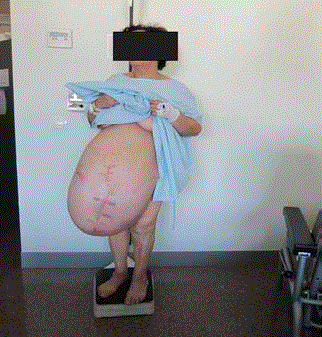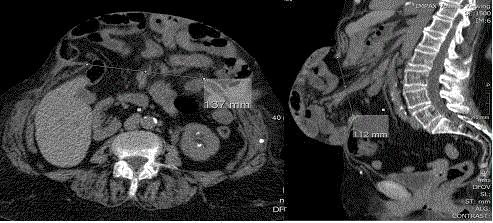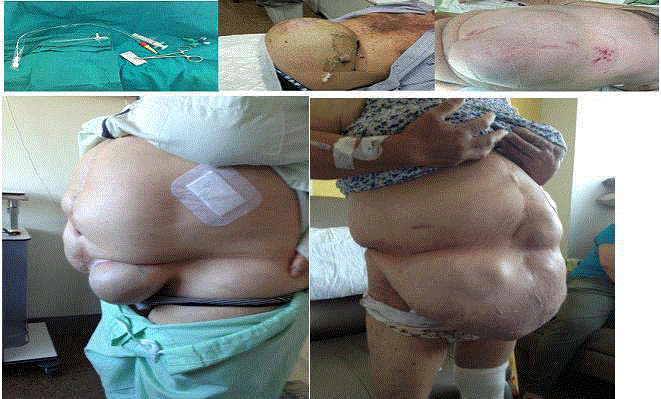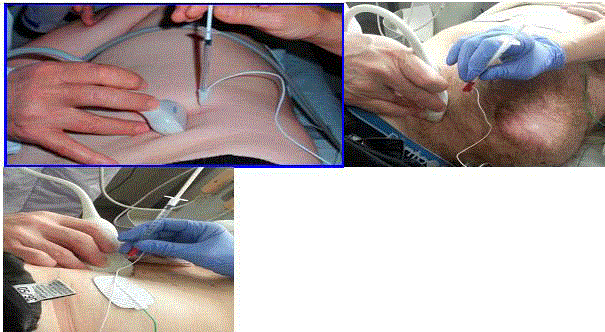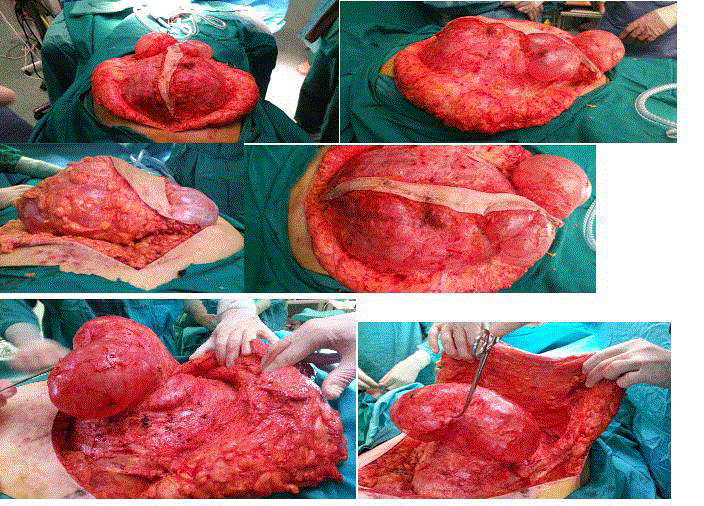Editorial
Should the Combined Use of Botulin Toxin and Progressive Preoperative Neumoperitoneum be Implemented in the Treatment of Large Abdominal Wall Ventral Hernia with Loss of Domain?
Antonio Torregrosa Gallud*
Department of Abdominal Wall Surgery, University and Politechnic Hospital La Fe, Spain
*Corresponding author: Antonio Torregrosa Gallud, Department of Abdominal Wall Surgery, University and Politechnic Hospital La Fe, Valencia, Spain
Published: 06 Feb, 2018
Cite this article as: Gallud AT. Should the Combined
Use of Botulin Toxin and Progressive
Preoperative Neumoperitoneum be
Implemented in the Treatment of Large
Abdominal Wall Ventral Hernia with
Loss of Domain?. Clin Surg. 2018; 3:
1899
Editorial
The closure and refunctionalization of the abdominal wall facing of a large ventral hernia with
loss of domain is one of the greatest challenges of surgeons of the abdominal wall; and there are
still problems that have not been solved (Figure 1). It is known the poor venous and lymphatic
return that occurs in that type of hernias due to the compression produced by the hernia defect;
likewise, there is a decrease in intra-abdominal pressure due to a decrease in abdominal capacity
and also an alteration in diaphragmatic and ventilatory dynamics as a consequence of this decrease
[1-4]. When we carry out the repair, the opposite effect occurs; that is, there is an increase in intraabdominal
pressure with the consequent decrease in venous return and the appearance of an
abdominal compartment syndrome; likewise, there is an elevation of the diaphragm determining
an increase in intrathoracic pressure and consequently the appearance of a possible respiratory
distress. All this determines the dehiscence of the hernial repair with the consequent recurrence
of the hernia. Bikhchandani et al. [5] in 2013 report physiological alterations of postural type
and in the ambulation, alterations of the respiration and defecatory and urinary changes with
the consequent alterations in the quality of life of the patients who have to change their lifestyle,
consequent negative economic repercussions and repeated subocclusive episodes and definitive loss
of self-esteem. As the hernia gets bigger and bigger, skin conditions worsen, atrophy and fibrosis
appears due to the disuse of the muscles of the lateral abdominal wall, the elasticity of the abdominal
wall disappears due to the loss of muscular elasticity and finally the rigidity of the entire Wall [6]..
Conceptually, the loss of domain on ventral hernia is not currently agreed upon; being for some
when the ratio between the volume of the hernial sac with respect to that of the abdominal cavity
is greater than 50% or higher than 100 cm2 (McAdory). Our group prefers to speak about Large
Incisional hernia when the ratio VIH/VAC es mayor Del 20% VIH: Volume of Incisional Hernia;
VAC: Volume of Abdominal Cavity (Figure 2). Faced with this enormous problem we are presented
with a suitable preoperative preparation that includes the progressive readaptation of all the organic
systems that allow the reintroduction of all the visceral content and the opportune reconstruction of
the abdominal wall. This preparation should be aimed at the correction of nutritional defects, weight
loss in obese, abstention or abstinence of tobacco, respiratory physiotherapy and attention to ulcers
or skin infections. As Scheuerlein H defends "In a loss-of-domain situation it is necessary to obtain
a valid estimation of the volume deficit as well as the cardio-pulmonary reserve pre-operatively
[7]. That could be made by Dynamic abdominal Wall CT and preoperative respiratory tests. Same
way the interdisciplinary co-operation during the post-operative recovery (intensive physiotherapy/
respiratory therapy, ICU, possibly post-operative mechanical ventilation) is important.
We are facing complex problems: 1. Larges hernias 2. Retracted muscles 3. Loss of Domain 4.
Time delay until repair; so “Beware of standards solutions for non-standard problems”
The objectives of our treatment should be like Klinge et al. [8] says:
• The refunctionalization of the abdominal wall (including muscular support),
• Prevention of visceral event ration and
• To get a suitable tissue cover.
So it is vital the aponeurotic coping of the hernial extremities, since the restructured wall functions as the primary support, the abdominal continent, and
prevents excessive tension on the mesh.
To achieve these objectives, many techniques have been tried:
A. Mechanical traction techniques (Intermuscular tissue
expanders (lateral abdominal Wall); Progressive pneumoperitoneum
(by slowly creating a chronic abdominal compartment syndrome);
Laparostomy with progressive mesh excision [9-11].
B. Anatomic Alteration: Reduction of abdominal content
(omentectomy, subtotal colectomy; Phrenicectomy (Tournoff),
Creation of ventral hernia [12]); Multiple relaxing incisions of anterior
rectus sheet Clotteau-Premont, Large relaxing incisions (Gibson’s
operation); Anterior component separation of Albanese (1946);
Anterior component Separation of Ramirez [13]|; Open component
separation over linea semilunaris and Lap assisted intermuscular
approach (Rosen).
C. Combination of both
D. Bridging repair. Synthetic Replacement
In these cases we should “Know what you will do in the event
that you don’t know what to do!!!” and “Always have a plan for the
worst-case scenario”
Historically was Goñi Moreno in 1940 who introduced the
preoperative progressive Pneumoperitoneum in the repair of great
ventral hernias; their purpose was a progressive distension of the
abdominal wall; a volumetric increase of the abdominal cavity, a
regularization of the respiratory function, a pneumatic dissection of
the abdominal flanges and adhesions, a peritoneal irritation allowing
a vasodilatation and the entering of the macrophages so presenting
a “Progressive restrictive syndrome.” From 1990 till today many
other authors use this technique like Mayagoitia, Dumont, Tanaka,
Sabbagh, Oprea [2,14]. It’s a prehistorical technique?? We consider
opposite to that and we use this technique easily making an Incision
in left subcostal quadrant under local anesthesia. The Introduction
of cavafix catheter (does not cause adhesions or decubitus) with an
antibacterial filter with radiologic control posterior [15-18]. There are
authors that made it under ultrasound control (Figure 3). Total final
volume as a function of defect size, abdominal cavity size, presence
of adhesions and individual patient tolerance. Our group uses three
times the herniary volume (Plus losses); the duration is variable
depending on the goal to be achieved and the patient tolerance; but
normally 7-10 days. Rappaport et al. [19] explains their benefits on the
reduction of visceral volume. After that the viscera almost completely
fit into the abdominal cavity.
But “it was enough with only this technique”; in our experience
NO. We have cases that we can close even in the cases where we used
PPP; so we decide to use another technique combined with PPP. This
was the Botulinum Toxin type A producing a Chemical Denervation
and consequently a flaccid paralysis.
The begin of the effect appears in days, the optimum effects in
3-4 weeks and the duration is 3-6 months. It produces a “Transient Chemical denervation” enlarging the abdominal cavity, lowering the
abdominal pressure getting an increase in the abdominal capacity
prior to elective hernia repair and it’s extended to the postoperative
period. In addition, it is a tool that does not weaken the wall
permanently and does not generate major postoperative pain [20-22].
Even the use of botulinum toxin type A in abdominal Wall repairs
begins experimentally before, was Ibarra Hurtado who reported their
use in the abdominal Wall hernia repair in 2009; he explain that the
use of botulinum Toxin reduces the thickness of the lateral muscles
and increase their length, so, decreasing the size of the defect. Other
authors like Zielinski, Zendejas, Chavez Tostado and our group
present similar results [23-26].
Technically in an Outpatient basis, approximately 30-40 days
before surgery, by Electromyography (EMG) and ultrasound guides.
Five points are identified on each side of the abdominal wall:
-2 points in the mid-axillary line between the rib margin and the
upper iliac crest
-3 points between the anterior axillary line and midclavicular line
between the costal margin and the superior iliac crest.
500 units of BT are infiltrated in the ten points: 50 units in all
layers muscle, using ultrasound guidance (Figure 4).
After that we begin to use the combined techniques and reported
our results in Hernia journal in September 2015 with 51 patients;
and today more than 70 cases. In our studies we have significative
differences between VIH, VAC and the ratio before and after using
BT-A+PPP; but we don't have significance in the diameter of the
size [27]. With that results, we conclude and emphasize on the
combined use of both techniques for the preparation and repair of
large abdominal wall hernias with a ratio VIH/VAC >20%. Definitely
under our viewpoint the combined techniques of Botulinum Toxin
type A and progressive preoperative pneumoperitoneum should be
implemented for the treatment of large and complex hernias of the
abdominal wall with loss of domain.
Figure 1
Figure 2
Figure 3
Figure 3
Material for the progressive preoperative pneumoperitoneum and
images of pneumoperitoneum in a different patients.
Figure 4
Figure 5
References
- Moreno IG. Chronic eventrations and large hernias; preoperative treatment by progressive pneumoperitoneum; original procedure. Surgery. 1947;22(6):945-53.
- Mayagoitia JC, Suárez D, Arenas JC, Díaz de León V. Preoperative progressive pneumoperitoneum in patients with abdominal-wall hernias. Hernia. 2006;10(3);213-7.
- Ali SD, Calhoun T, Kurtz LH. The use of pneumoperitoneum in the treatment of megaherniae. J Natl Med Assoc. 1975;67(1):16-8.
- Rodríguez Ortega M, Fernández Lobato R, Garaulet González P, Ríos Blanco R, Jiménez Carneros V, Limones Esteban M. [Use of pneumoperitoneum in the repair of giant abdominal hernias]. Cir Esp. 2006;80(4):220-3.
- Bikhchandani J, Fitzgibbons RJ Jr. Repair of giant ventral hernias. Adv Surg. 2013;47:1-27.
- DuBay DA, Choi W, Urbanchek MG, Wang X, Adamson B, Dennis RG, et al. Incisional herniation induces decreased abdominal wall compliance via oblique muscle atrophy and fibrosis. Ann Surg. 2007;245(1):140-6.
- Scheuerlein H, Settmacher U, Lenschow M, Rauchfuss F. Complex Incisional Hernias. Arch Clin Gastroenterol. 2016;2(2):17-26.
- Klinge U, Conze J, Krones CJ, Schumpelick V. Incisional hernia: open techniques. World J Surg. 2005;29(8):1066-72.
- Winfield R, Del Guercio L. The Place for Pneumoperitoneum in the Repair of Massive Hernia. World J Surg. 1989;13(5):581-5.
- Koontz AR, Graves JW. Preoperative pneumoperitoneum as an aid in the handling of gigantic hernias. Ann Surg. 1954;140(5):759-62.
- Touroff AS. Phrenicetomy as aid to repair of large abdominal hernias. J Am Med Assoc. 1954;154(4):330-2.
- Ziffren SE, Womack Na. An operative approach to the treatment of gigantic hernias. Surg Gynecol Obstet. 1950;91(6):709-10.
- Ramirez OM, Ruas E, Dellon AL. "Components separation" method for closure of abdominal-wall defects: an anatomic and clinical study. Plast Reconstr Surg. 1990;86(3):519-26.
- Sabbagh C, Dumont F, Fuks D, Yzet T, Verhaeghe P, Regimbeau JM. Progressive preoperative pneumoperitoneum preparation (the Goñi Moreno protocol) prior to large incisional hernia surgery: volumetric, respiratory and clinical impacts. A prospective study. Hernia. 2012;16(1):33-40.
- Turgut Piskin, Cemalettin Aydin, Bora Barut, Abuzer Dirican, Cuneyt Kayaalp. Preoperative progressive pneumoperitoneum for giant inguinal hernias. Ann Saudi Med. 2010;30(4):317-20.
- Coelho JC, Brenner AS, Freitas AT, Campos AC, Wiederkehr JC. Progressive preoperative pneumoperitoneum in the repair of large abdominal hernias. Eur J Surg. 1993;159(6-7):339-41.
- Renard Y, Lardière-Deguelte S, de Mestier L, Appere F, Colosio A, Kianmanesh R, et al. Management of large incisional hernias with loss of domain: A prospective series of patients prepared by progressive preoperative pneumoperitoneum. Surgery. 2016;160(2):426-35.
- Mcadory RS, Cobb WS, Carbonell AM. Progressive preoperative pneumoperitoneum for hernias with loss of domain. Am Surg. 2009;75(6):504-8.
- Jaime Rappaport Stramwasser, Jaime Carrasco Toledo, Juan Jorge Silva Solís, Marco Albán García, Francisco Papic Silva. [Preoperative therapeutic pneumoperitoneum in the treatment of giant incisional hernia. Reduction of visceral volume as a physiopathological explanation of its benefits]. Rev Hisp Hernia. 2014;2(2):41-7.
- Ibarra-Hurtado TR, Nuño-Guzmán CM, Echeagaray-Herrera JE, Robles-Vélez E, de Jesús González-Jaime J. Use of botulinum toxin type a before abdominal wall hernia reconstruction. World J Surg. 2009;33(12):2553-6.
- Cakmak M, Caglayan F, Somuncu S, Leventoglu A, Ulusoy S, Akman H, et al. Effect of paralysis of the abdominal wall muscles by botulinum A toxin to intraabdominal pressure: an experimental study. J Pediatr Surg. 2006;41(4):821-5.
- Ibarra Hurtado TR. [Botulinum toxin type A: Its importance in patients with large abdominal hernias]. Rev Hispan Hernia. 2014;2(4):131-2.
- Farooque F, Jacombs AS, Roussos E, Read JW, Dardano AN, Edye M, et al. Preoperative abdominal muscle elongation with botulinum toxin A for complex incisional ventral hernia repair. ANZ J Surg. 2016;86(1-2):79-83.
- Elstner KE, Jacombs AS, Read JW, Rodriguez O, Edye M, Cosman PH, et al. Laparoscopic repair of complex ventral hernia facilitated by pre-operative chemical component relaxation using Botulinum Toxin. Hernia. 2016;20(2):209-19.
- Bueno-Lledó J, Torregrosa Gallud A, Jiménez Rosellón R, Carbonell Tatay F, García Pastor P, Bonafé Diana S, et al. Preoperative preparation of «loss of domain» hernia. Progressive pneumoperitoneum and botulinum toxin type A. Cir Esp. 2017;95(5):245-53.
- Karla Verónica Chávez Tostado, Luis Eduardo Cárdenas Lailson, Haydée Pérez Trigos.
[Results of preoperative application of botulinum toxin type A in treatment of giant incisional hernias]. Revista Hispanoamericana de Hernia. 2014;2(4):145-51. - Sebastián Barber Millet, Omar Carreño Saenz, Manuel de Juan Burgueño, Fernando Carbonell Tatay.
[Injecting botulinum toxin in the abdominal wall prior to the surgical repair of a giant Morgagni hernia]. Revista Hispanoamericana de Hernia. 2015;3(2):65-9.

